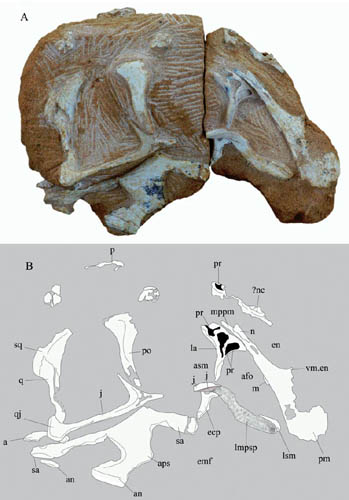Dr. XU Xing, Institute of Vertebrate Paleontology and Paleoanthropology (IVPP), Chinese Academy of Sciences, and his team recently carried out several expeditions to Bayan Mandahu, Linhe, Nei Mongol, China, and have unearthed multiple dinosaur, mammal, and lizard specimens. In a paper published in the journal of Vertebrata PalAsiatica 51(2), the team reported a new oviraptorid, Wulatelong gobiensis gen. et sp. nov., based on a nearly complete skeleton collected from the Upper Cretaceous Wulansuhai Formation of Bayan Mandahu during the 2009 field season. This specimen represents the third oviraptorid species known from the Bayan Mandahu area, providing new data for better understanding the Late Cretaceous dinosaur faunas of the Gobi area.
Although badly weathered, this new specimen is an articulated skeleton preserving much of the cranium and postcranial skeleton, including 11 dorsal vertebrae, 16 caudal vertebrae, much of both the right and left scapulocoracoids, a partial sternum, a partial left humerus, much of the left manus, a nearly complete right pelvic girdle, and the right hindlimb.
Wulatelong gobiensis is distinguishable from other oviraptorid species by the following unique features: the ventral extremity of the large and elongate external naris is located below the mid-height of the premaxilla, the strap-like jugal process of the maxilla extends well beyond the preorbital bar posteriorly and overlaps the jugal, and the anterodorsal process of the surangular is basally constricted in lateral view.
"Although diagnosable as an oviraptorid, this new taxon possesses several plesiomorphic features absent in other oviraptorids but reminiscent of more basal oviraptorosaurs, suggesting a relatively basal position within the Oviraptoridae”, said XU Xing, lead author of the study.
Wulatelong gobiensis is probably an adult individual as indicated by the complete closure of the neurocentral sutures of all exposed dorsal vertebrae. With a femoral length of about 255 mm, the specimen is a small oviraptorid, though it is still considerably larger than most basal oviraptorosaurs. Researchers estimated the body mass of Wulatelong gobiensis to be about 29 kg based on an empirical equation developed using measurements from complete non-avian theropod skeletons and body mass estimates based on water displacement experiments with reconstructed models.
This study was supported by the National Natural Science Foundation of China and the Chinese Academy of Sciences.

Fig.1 Photograph (A) and line-drawing (B) of skull and mandible of holotype specimen of Wulatelong gobiensis gen. et sp. nov. (IVPP V 18409) in right lateral view. (Image by XU Xing)

Fig.2 Photograph (A) and line-drawing (B) of postcranial skeleton of holotype specimen of Wulatelong gobiensis gen. et sp. nov. (IVPP V 18409) (Image by XU Xing)

Fig.3 Photograph (A) and line-drawing (B) of right pes of holotype specimen of Wulatelong gobiensis gen. et sp. nov. (IVPP V 18409) (Image by XU Xing)


